belt CADILLAC ESCALADE EXT 2007 3.G Owners Manual
[x] Cancel search | Manufacturer: CADILLAC, Model Year: 2007, Model line: ESCALADE EXT, Model: CADILLAC ESCALADE EXT 2007 3.GPages: 580, PDF Size: 3.01 MB
Page 1 of 580

Seats and Restraint Systems....................... 7
Front Seats
.............................................. 8
Rear Seats
............................................. 16
Safety Belts
............................................ 18
Child Restraints
...................................... 39
Airbag System
........................................ 67
Restraint System Check
......................... 86
Features and Controls................................ 89
Keys
....................................................... 91
Doors and Locks
.................................. 101
Windows
............................................... 115
Theft-Deterrent Systems
....................... 117
Starting and Operating Your Vehicle
..... 123
Mirrors
.................................................. 143
OnStar
®System
................................... 152
Universal Home Remote System
.......... 154
Storage Areas
...................................... 165
Sunroof
................................................ 187Instrument Panel....................................... 189
Instrument Panel Overview
................... 192
Climate Controls
................................... 219
Warning Lights, Gages, and
Indicators
.......................................... 225
Driver Information Center (DIC)
............ 243
Audio System(s)
................................... 267
Driving Your Vehicle................................. 321
Your Driving, the Road, and
Your Vehicle
..................................... 322
Towing
................................................. 378
Service and Appearance Care.................. 393
Service
................................................. 396
Fuel
...................................................... 399
Checking Things Under the Hood
......... 404
All-Wheel Drive
..................................... 443
Rear Axle
............................................. 444
Front Axle
............................................ 446
2007 Cadillac Escalade EXT Owner ManualM
1
Page 7 of 580
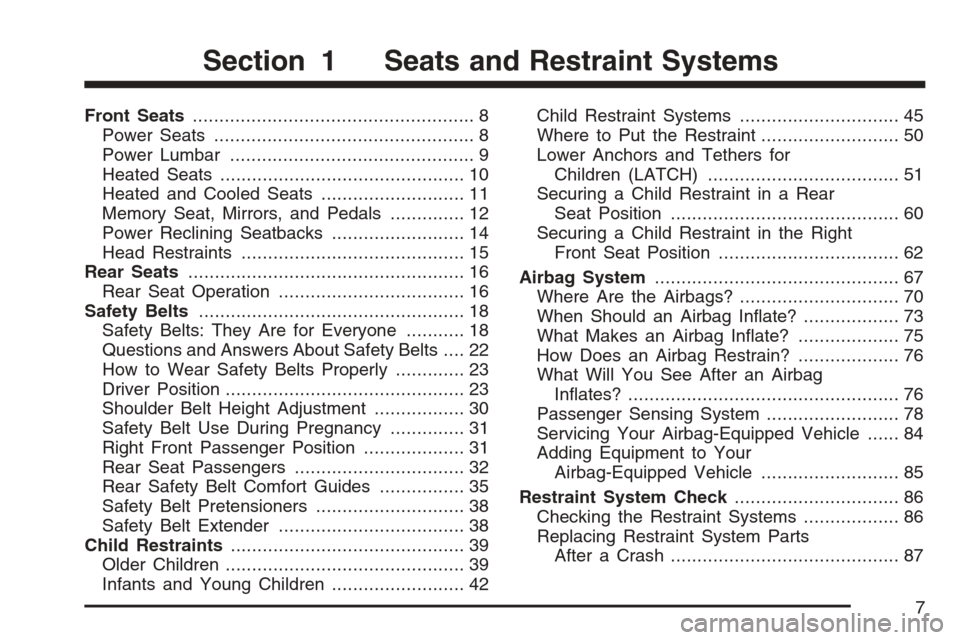
Front Seats..................................................... 8
Power Seats................................................. 8
Power Lumbar.............................................. 9
Heated Seats.............................................. 10
Heated and Cooled Seats........................... 11
Memory Seat, Mirrors, and Pedals.............. 12
Power Reclining Seatbacks......................... 14
Head Restraints.......................................... 15
Rear Seats.................................................... 16
Rear Seat Operation................................... 16
Safety Belts.................................................. 18
Safety Belts: They Are for Everyone........... 18
Questions and Answers About Safety Belts.... 22
How to Wear Safety Belts Properly............. 23
Driver Position............................................. 23
Shoulder Belt Height Adjustment................. 30
Safety Belt Use During Pregnancy.............. 31
Right Front Passenger Position................... 31
Rear Seat Passengers................................ 32
Rear Safety Belt Comfort Guides................ 35
Safety Belt Pretensioners............................ 38
Safety Belt Extender................................... 38
Child Restraints............................................ 39
Older Children............................................. 39
Infants and Young Children......................... 42Child Restraint Systems.............................. 45
Where to Put the Restraint.......................... 50
Lower Anchors and Tethers for
Children (LATCH).................................... 51
Securing a Child Restraint in a Rear
Seat Position........................................... 60
Securing a Child Restraint in the Right
Front Seat Position.................................. 62
Airbag System.............................................. 67
Where Are the Airbags?.............................. 70
When Should an Airbag In�ate?.................. 73
What Makes an Airbag In�ate?................... 75
How Does an Airbag Restrain?................... 76
What Will You See After an Airbag
In�ates?................................................... 76
Passenger Sensing System......................... 78
Servicing Your Airbag-Equipped Vehicle...... 84
Adding Equipment to Your
Airbag-Equipped Vehicle.......................... 85
Restraint System Check............................... 86
Checking the Restraint Systems.................. 86
Replacing Restraint System Parts
After a Crash........................................... 87
Section 1 Seats and Restraint Systems
7
Page 14 of 580
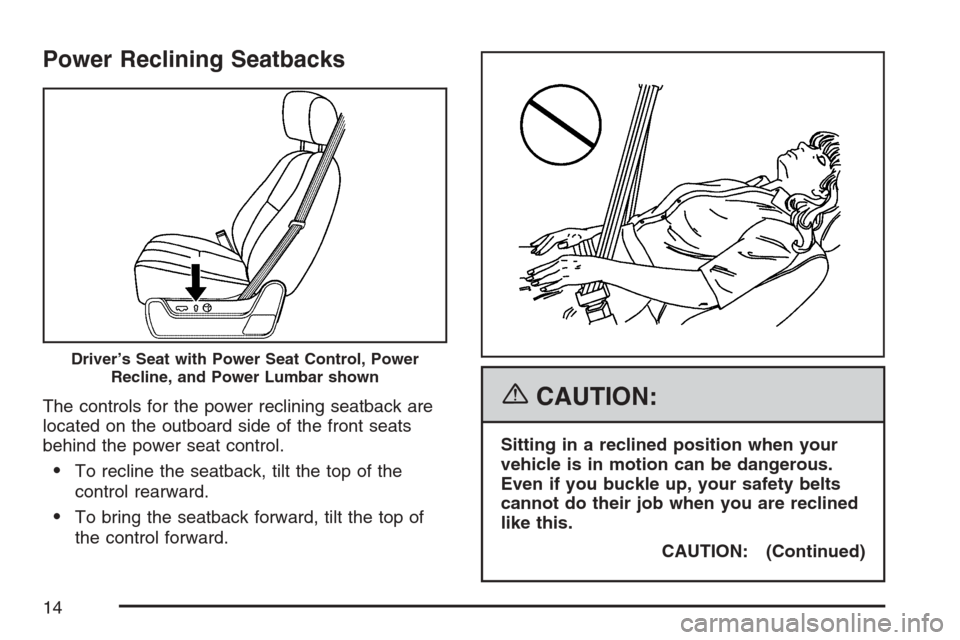
Power Reclining Seatbacks
The controls for the power reclining seatback are
located on the outboard side of the front seats
behind the power seat control.
To recline the seatback, tilt the top of the
control rearward.
To bring the seatback forward, tilt the top of
the control forward.
{CAUTION:
Sitting in a reclined position when your
vehicle is in motion can be dangerous.
Even if you buckle up, your safety belts
cannot do their job when you are reclined
like this.
CAUTION: (Continued)
Driver’s Seat with Power Seat Control, Power
Recline, and Power Lumbar shown
14
Page 15 of 580
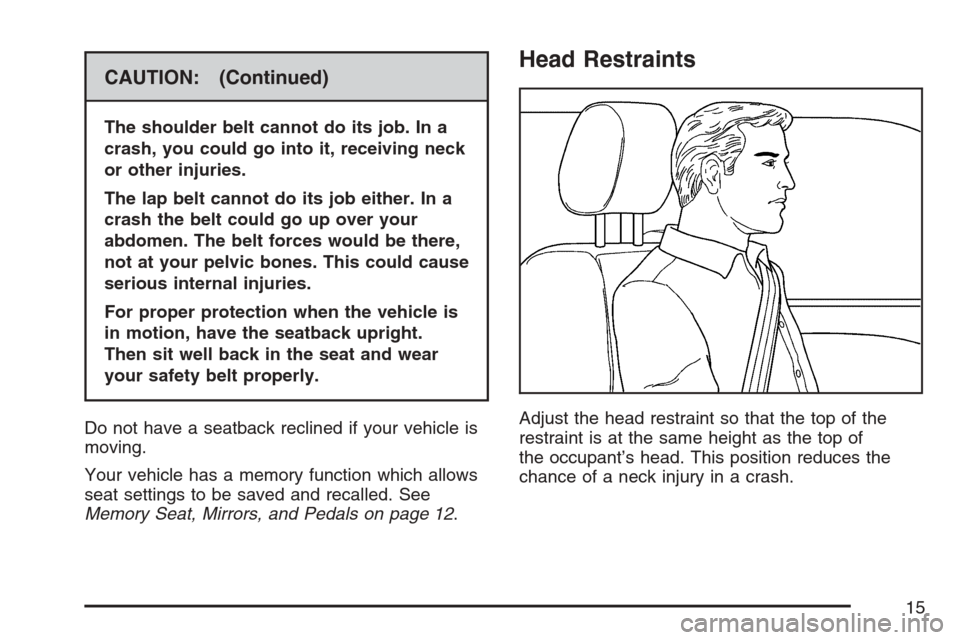
CAUTION: (Continued)
The shoulder belt cannot do its job. In a
crash, you could go into it, receiving neck
or other injuries.
The lap belt cannot do its job either. In a
crash the belt could go up over your
abdomen. The belt forces would be there,
not at your pelvic bones. This could cause
serious internal injuries.
For proper protection when the vehicle is
in motion, have the seatback upright.
Then sit well back in the seat and wear
your safety belt properly.
Do not have a seatback reclined if your vehicle is
moving.
Your vehicle has a memory function which allows
seat settings to be saved and recalled. See
Memory Seat, Mirrors, and Pedals on page 12.
Head Restraints
Adjust the head restraint so that the top of the
restraint is at the same height as the top of
the occupant’s head. This position reduces the
chance of a neck injury in a crash.
15
Page 17 of 580
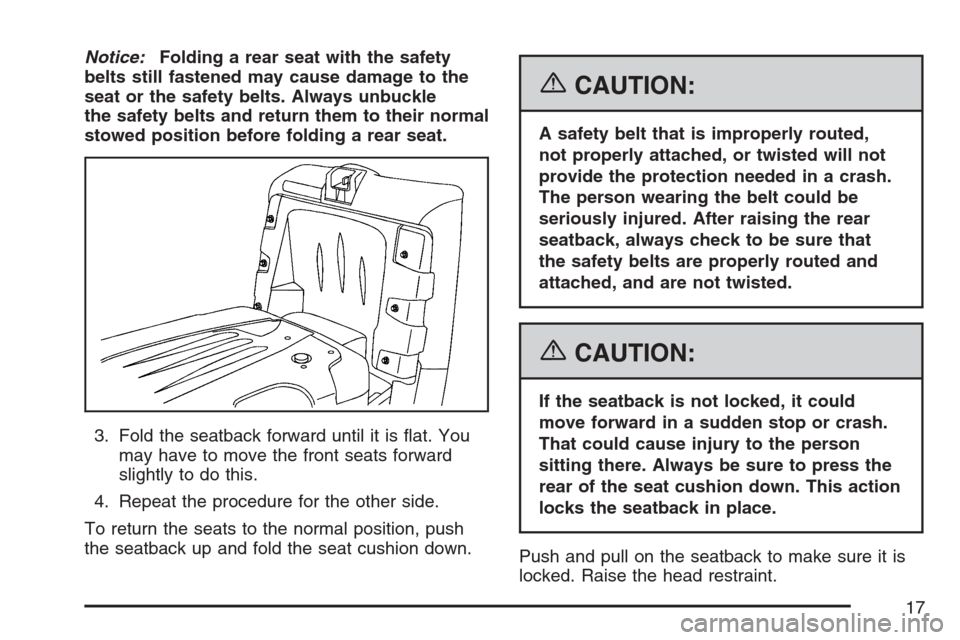
Notice:Folding a rear seat with the safety
belts still fastened may cause damage to the
seat or the safety belts. Always unbuckle
the safety belts and return them to their normal
stowed position before folding a rear seat.
3. Fold the seatback forward until it is �at. You
may have to move the front seats forward
slightly to do this.
4. Repeat the procedure for the other side.
To return the seats to the normal position, push
the seatback up and fold the seat cushion down.
{CAUTION:
A safety belt that is improperly routed,
not properly attached, or twisted will not
provide the protection needed in a crash.
The person wearing the belt could be
seriously injured. After raising the rear
seatback, always check to be sure that
the safety belts are properly routed and
attached, and are not twisted.
{CAUTION:
If the seatback is not locked, it could
move forward in a sudden stop or crash.
That could cause injury to the person
sitting there. Always be sure to press the
rear of the seat cushion down. This action
locks the seatback in place.
Push and pull on the seatback to make sure it is
locked. Raise the head restraint.
17
Page 18 of 580
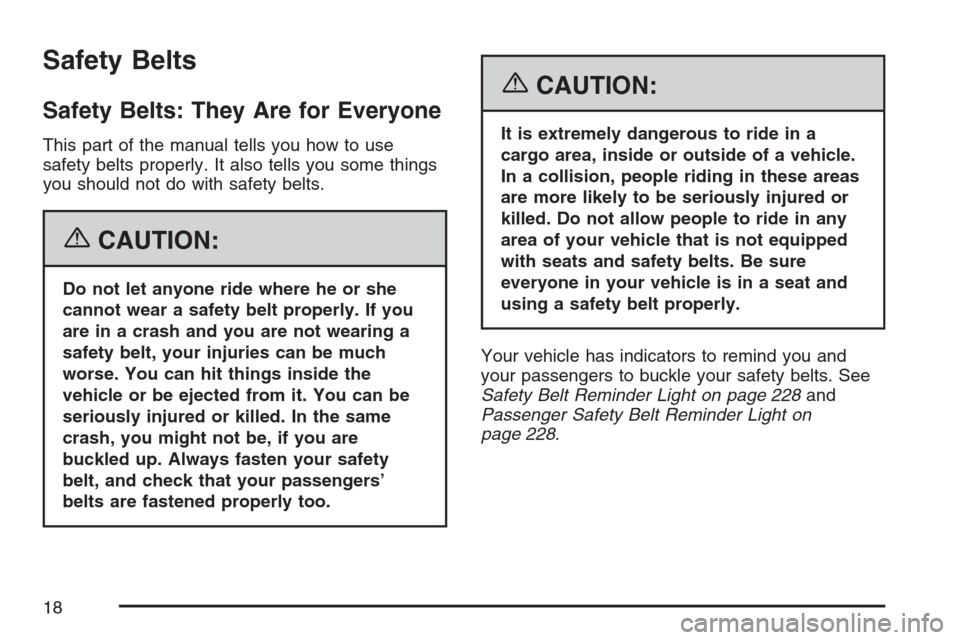
Safety Belts
Safety Belts: They Are for Everyone
This part of the manual tells you how to use
safety belts properly. It also tells you some things
you should not do with safety belts.
{CAUTION:
Do not let anyone ride where he or she
cannot wear a safety belt properly. If you
are in a crash and you are not wearing a
safety belt, your injuries can be much
worse. You can hit things inside the
vehicle or be ejected from it. You can be
seriously injured or killed. In the same
crash, you might not be, if you are
buckled up. Always fasten your safety
belt, and check that your passengers’
belts are fastened properly too.
{CAUTION:
It is extremely dangerous to ride in a
cargo area, inside or outside of a vehicle.
In a collision, people riding in these areas
are more likely to be seriously injured or
killed. Do not allow people to ride in any
area of your vehicle that is not equipped
with seats and safety belts. Be sure
everyone in your vehicle is in a seat and
using a safety belt properly.
Your vehicle has indicators to remind you and
your passengers to buckle your safety belts. See
Safety Belt Reminder Light on page 228and
Passenger Safety Belt Reminder Light on
page 228.
18
Page 19 of 580
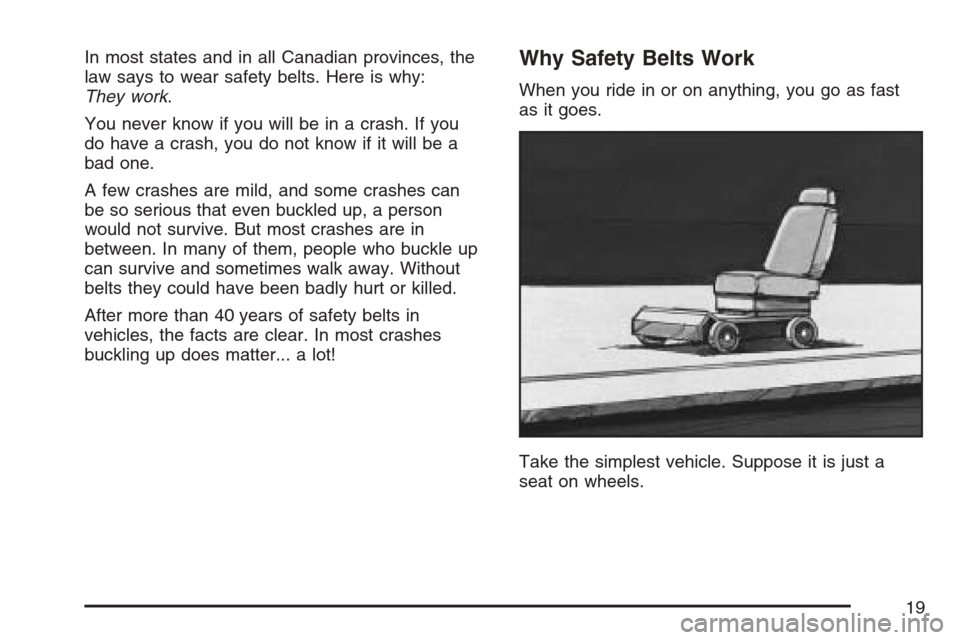
In most states and in all Canadian provinces, the
law says to wear safety belts. Here is why:
They work.
You never know if you will be in a crash. If you
do have a crash, you do not know if it will be a
bad one.
A few crashes are mild, and some crashes can
be so serious that even buckled up, a person
would not survive. But most crashes are in
between. In many of them, people who buckle up
can survive and sometimes walk away. Without
belts they could have been badly hurt or killed.
After more than 40 years of safety belts in
vehicles, the facts are clear. In most crashes
buckling up does matter... a lot!Why Safety Belts Work
When you ride in or on anything, you go as fast
as it goes.
Take the simplest vehicle. Suppose it is just a
seat on wheels.
19
Page 22 of 580
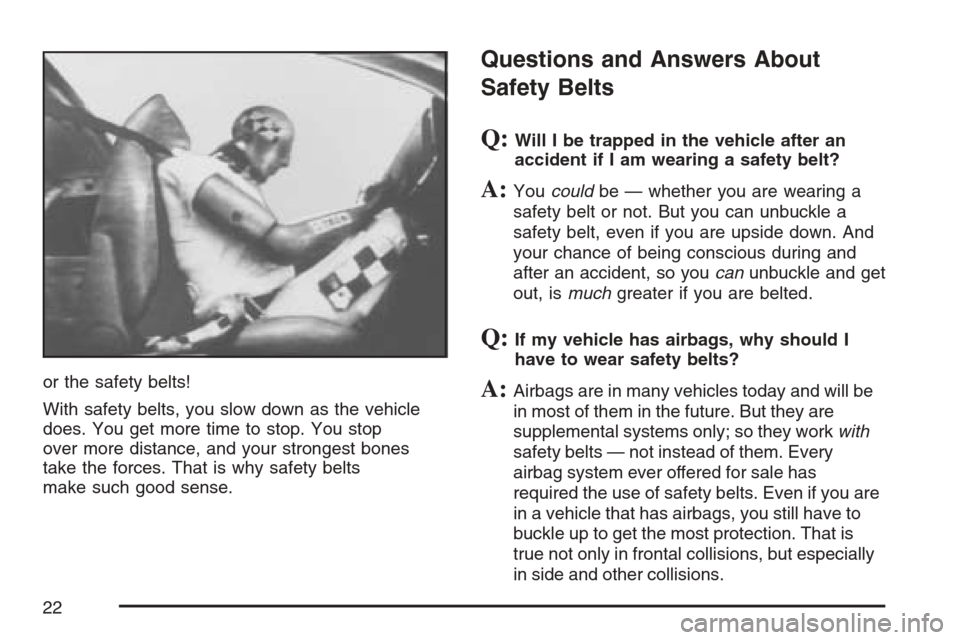
or the safety belts!
With safety belts, you slow down as the vehicle
does. You get more time to stop. You stop
over more distance, and your strongest bones
take the forces. That is why safety belts
make such good sense.
Questions and Answers About
Safety Belts
Q:Will I be trapped in the vehicle after an
accident if I am wearing a safety belt?
A:Youcouldbe — whether you are wearing a
safety belt or not. But you can unbuckle a
safety belt, even if you are upside down. And
your chance of being conscious during and
after an accident, so youcanunbuckle and get
out, ismuchgreater if you are belted.
Q:If my vehicle has airbags, why should I
have to wear safety belts?
A:Airbags are in many vehicles today and will be
in most of them in the future. But they are
supplemental systems only; so they workwith
safety belts — not instead of them. Every
airbag system ever offered for sale has
required the use of safety belts. Even if you are
in a vehicle that has airbags, you still have to
buckle up to get the most protection. That is
true not only in frontal collisions, but especially
in side and other collisions.
22
Page 23 of 580
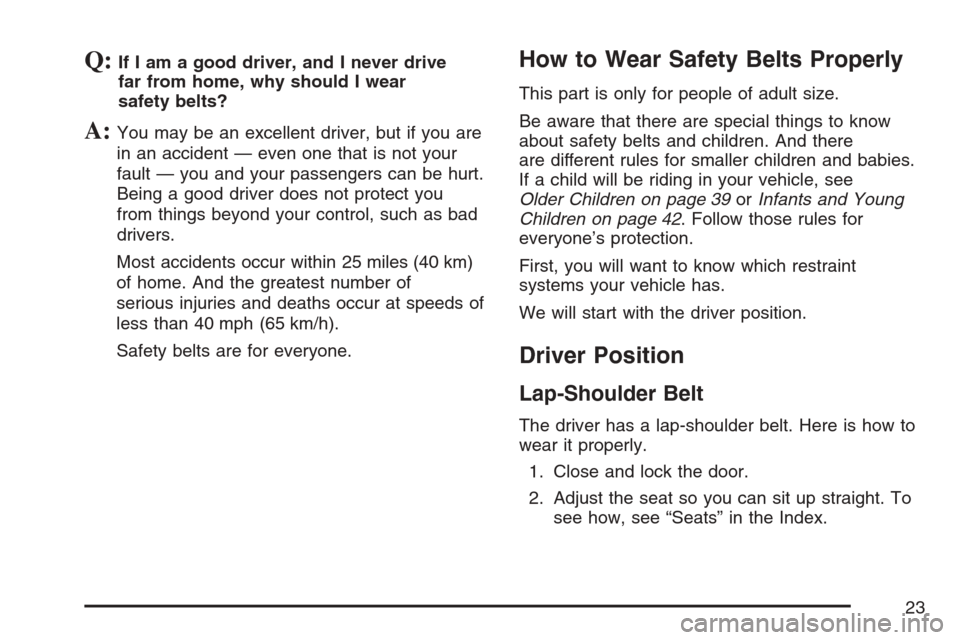
Q:If I am a good driver, and I never drive
far from home, why should I wear
safety belts?
A:You may be an excellent driver, but if you are
in an accident — even one that is not your
fault — you and your passengers can be hurt.
Being a good driver does not protect you
from things beyond your control, such as bad
drivers.
Most accidents occur within 25 miles (40 km)
of home. And the greatest number of
serious injuries and deaths occur at speeds of
less than 40 mph (65 km/h).
Safety belts are for everyone.
How to Wear Safety Belts Properly
This part is only for people of adult size.
Be aware that there are special things to know
about safety belts and children. And there
are different rules for smaller children and babies.
If a child will be riding in your vehicle, see
Older Children on page 39orInfants and Young
Children on page 42. Follow those rules for
everyone’s protection.
First, you will want to know which restraint
systems your vehicle has.
We will start with the driver position.
Driver Position
Lap-Shoulder Belt
The driver has a lap-shoulder belt. Here is how to
wear it properly.
1. Close and lock the door.
2. Adjust the seat so you can sit up straight. To
see how, see “Seats” in the Index.
23
Page 24 of 580
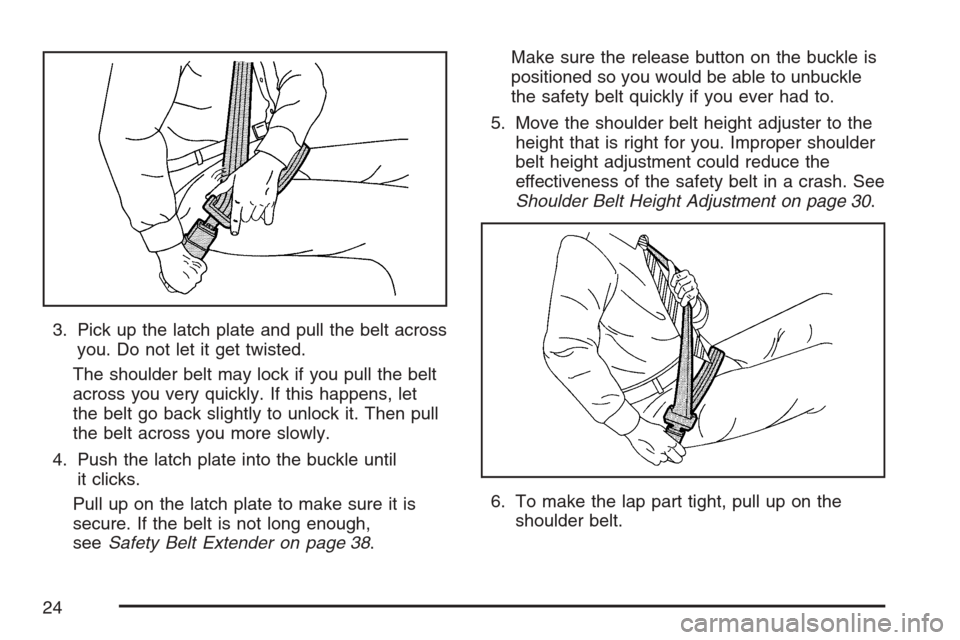
3. Pick up the latch plate and pull the belt across
you. Do not let it get twisted.
The shoulder belt may lock if you pull the belt
across you very quickly. If this happens, let
the belt go back slightly to unlock it. Then pull
the belt across you more slowly.
4. Push the latch plate into the buckle until
it clicks.
Pull up on the latch plate to make sure it is
secure. If the belt is not long enough,
seeSafety Belt Extender on page 38.Make sure the release button on the buckle is
positioned so you would be able to unbuckle
the safety belt quickly if you ever had to.
5. Move the shoulder belt height adjuster to the
height that is right for you. Improper shoulder
belt height adjustment could reduce the
effectiveness of the safety belt in a crash. See
Shoulder Belt Height Adjustment on page 30.
6. To make the lap part tight, pull up on the
shoulder belt.
24